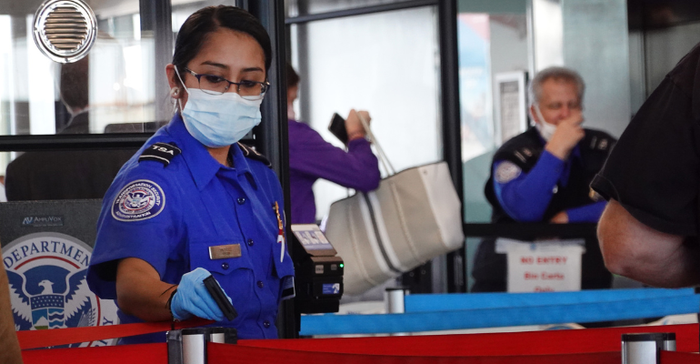Coming to America: Rebuilding the US PPE Supply Chain
Rebuilding the domestic PPE supply chain has been challenging to say the least. Despite the obstacles, however, there are some success stories.
June 28, 2023

The acute phase of the COVID-19 pandemic came to an end in May, but memories of the early panic and confusion still haunt those who witnessed overwhelmed hospitals, helpless critically ill patients, and a lack of personal protective equipment (PPE) for healthcare workers.
Shortly after the news of PPE shortages broke, government agencies took action to address the critical supply shortage. For example, the Defense Department has been involved since the early days of the pandemic, engaging in activities such as contracting with PPE manufacturers and issuing restrictions on purchasing PPE from "non-allied" foreign nations, including China.
However, rebuilding the domestic PPE supply chain has not been a straightforward success. Many companies that received grants and emergency funding eventually gave up, citing reasons such as regulatory obstacles and existing contractual relationships that prevented them from entering the market.
Nevertheless, the effort to bring PPE production back to the United States has had its success stories. Experts who have studied the market and taken a long-term perspective believe that there are still numerous opportunities to keep production within the country and prevent future emergencies from causing severe shortages.
Strategic planning leads to success
Jacob Block, the founder of American Nitrile, located in Grove City, a suburb of Columbus, OH, had extensive knowledge of the PPE supply chain when he established the company in 2021. During the initial phases of the pandemic, Block worked as a supply broker and had access to Chinese factories and government officials in need of PPE.
Block and his team capitalized on this opportunity by quickly importing and selling PPE. However, after a couple of months, they began questioning why the United States produced zero percent of its PPE domestically. Through careful analysis, they realized that establishing a domestic source for most forms of PPE was not feasible due to low barriers to entry, challenges in building a brand, and relatively low usage.
“We did not feel that way about nitrile gloves, and that’s why we built the glove factory for all the reasons we didn’t like masks and gowns," Block told MD+DI. "We felt we could produce gloves here for near cost parity to what they can in Asia. That mainly stems from automation, leveling the arbitrage and labor on the two continents. Energy is actually cheaper here and the largest market globally is the U.S. – we consume four out of every 10 gloves. People appreciate a shorter supply chain they have visibility into. Those reasons are why we built a factory here.”
The factory, spanning 530,000 square feet, currently operates three fabrication lines (with plans to scale up to six lines) and produces roughly 3 million gloves daily. Block expects the employee count to reach around 400, with about 120 employees currently. Two key factors contributing to the company's promising future are the significant capital raised through equity and debt financing (totaling $35 million and $105 million, respectively) and a diversified marketing strategy targeting both government agencies and the private market.
“The market for nitrile gloves is very different from the market for masks and gowns,” he said. “Nitrile gloves touch pretty much every industry.”

Block mentioned a recent partnership with the Central Association for the Blind and Visually Impaired (CABVI) to supply gloves to the Transportation Security Administration (TSA) as an example of their creative contracting approach. This deal was made possible through an AbilityOne contract that aims to employ people with disabilities and comply with the Make PPE in America Act, which mandates long-term procurement contracts for domestically manufactured PPE. As a result, American Nitrile gloves will be used at all 400 airports staffed by TSA. Despite pursuing government business as required by law, Block emphasized that the company's foundation and growth did not rely solely on government contracts; they also supply gloves to hospitals and Fortune 100 food processing companies.
Speaking with a unified voice on PPE reshoring

Another well-financed glove manufacturer, Baltimore, MD-based United Safety Technology, was founded at one of the lowest points of the PPE shortages in 2020 by finance executive and serial entrepreneur Dan Izhaky.
Izhaky also serves as the president of the American Medical Manufacturers Association (AMMA), a new industry advocacy organization that aims to keep the re-shoring of PPE components at the forefront of policymakers' minds. The AMMA emerged from informal discussions among individuals who had initiated efforts to bring the PPE market back within U.S. borders.
Recognizing the need for governmental support and intervention, the participants decided to organize and speak with a unified voice. The organization officially launched in February and evolved from the American Mask Manufacturers Association, which was formed in 2021. Izhaky explained that the name change reflects the broader focus on domestic PPE manufacturing, including masks, gowns, and other essential items. Izhaky said the goal is to have as much PPE domestically produced as possible.
"Basically, anything that can be highly automated will allow us to compete, but in addition to that there are things that need to happen from a legislative and policy perspective that levels the playing field between domestically manufactured PPE and imports," he told MD+DI.
Izhaky cited the Centers for Medicare and Medicaid Services' decision to provide cost differentials to hospitals purchasing domestically made N95 respirators starting in January 2023 as an example of a federal initiative that levels the playing field between domestically manufactured PPE and imports.
“That will help equalize the field and help on the demand side, because hospitals are the biggest buyers of PPE in the U.S. and they are all having tough times in a number of different areas,” he said. “They are not in a position to pay more for domestically manufactured PPE even though they see the value of it.”
Strategic thinking and starting small
While the prices of domestic PPE are often higher than for those made elsewhere, the memories of COVID-caused shortages are still fresh enough that provider systems still prioritize goods made here, according to Cristina Indiveri, associate vice president for strategic programs and contract services at Vizient, a member-owned services organization which includes the nation’s largest group purchasing organization among its portfolio.
“The demand for domestically manufactured products has certainly fluctuated, but I would still say with incredible confidence that our members are still prioritizing domestically manufactured products,” Indiveri told MD+DI.
Indiveri said the cost of domestic PPE is often the first question from a purchaser, but that asking them to try to dedicate a small percentage of their budget to domestically made goods is a doable solution.
“We usually start with 5% to 10%, but we have a few providers who can go higher, and we really want to be able to provide customized solutions,” Indiveri said. “But starting small shows them we are not here to focus on specific products, we are here offering a full suite of supply assurance solutions.”
Vizient recently signed an agreement with SafeSource Direct, a nitrile glove manufacturer based in Broussard, LA, to make their gloves available to members. SafeSource is a joint venture between Northport, AL-based Trax Development and New Orleans, LA-based Ochsner Health. Ochsner Health operates 46 hospitals and over 370 clinics and healthcare facilities in the Gulf South.
Indiveri said Ochsner's foray into PPE manufacturing could serve as an example for the future.
“That solid foundational partner we have been able to create with Ochsner improves confidence in supply availability and improves transparency,” she said. “It strengthens relationships just not between providers but also provides the healthcare economy with innovation, with creating local jobs, and allows us to ramp up production in times of shortage, too.”
The efforts to re-shore PPE production in the United States have faced challenges but also achieved notable successes. The strategic planning and entrepreneurial spirit of companies like American Nitrile and United Safety Technology, along with industry advocacy organizations like the AMMA, are helping rebuild the domestic PPE supply chain. Despite the higher costs, there is still strong demand for domestically manufactured PPE, and organizations like Vizient are working with providers to gradually increase their allocation of domestically made products. These efforts aim to ensure a robust supply of PPE in the country and reduce dependence on foreign sources during future emergencies.
About the Author(s)
You May Also Like

.png?width=300&auto=webp&quality=80&disable=upscale)
